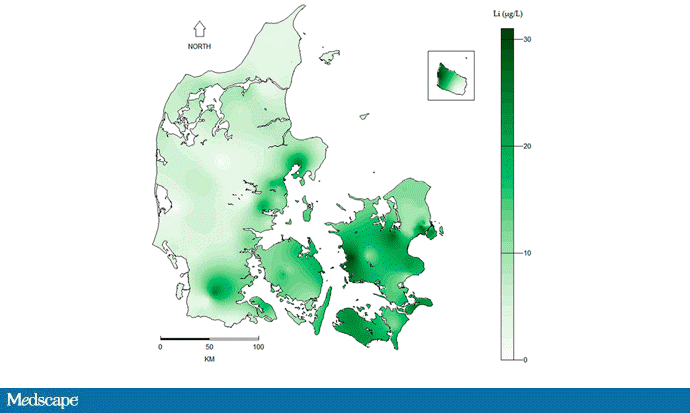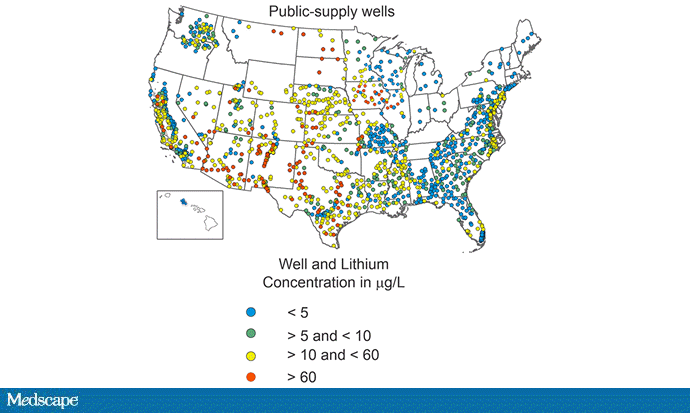This transcript has been edited for clarity.
Few conditions have stymied explanation like autism spectrum disorder (ASD). We know that the prevalence has been increasing dramatically, but we aren't quite sure whether that is due to more screening and awareness or more fundamental changes. We know that much of the risk appears to be genetic, but there may be 1000 genes involved in the syndrome. We know that certain environmental exposures, like pollution, might increase the risk — perhaps on a susceptible genetic background — but we're not really sure which exposures are most harmful.
So, the search continues, across all domains of inquiry from cell culture to large epidemiologic analyses. And this week, a new player enters the field, and, as they say, it's something in the water.
Does exposure to lithium in groundwater cause autism?
We're talking about this paper, by Zeyan Liew and colleagues, appearing in JAMA Pediatrics.
Using the incredibly robust health data infrastructure in Denmark, the researchers were able to identify 8842 children born between 2000 and 2013 with ASD and matched each one to five control kids of the same sex and age without autism.
They then mapped the location the mothers of these kids lived while they were pregnant — down to 5 meters resolution, actually — to groundwater lithium levels.

Once that was done, the analysis was straightforward. Would moms who were pregnant in areas with higher groundwater lithium levels be more likely to have kids with ASD?
The results show a rather steady and consistent association between higher lithium levels in groundwater and the prevalence of ASD in children.

We're not talking huge numbers, but moms who lived in the areas of the highest quartile of lithium were about 46% more likely to have a child with ASD. That's a relative risk, of course — this would be like an increase from 1 in 100 kids to 1.5 in 100 kids. But still, it's intriguing.
But the case is far from closed here.
First of all, groundwater concentration of lithium and the amount of lithium a pregnant mother ingests is not the same thing. It does turn out that virtually all drinking water in Denmark comes from groundwater sources — but not all lithium comes from drinking water. There are plenty of dietary sources of lithium as well. And, of course, there is medical lithium, but we'll get to that in a second.

First, let's talk about those lithium measurements. They were taken in 2013 — after all these kids were born. The authors acknowledge this limitation but show a high correlation between measured levels in 2013 and earlier measured levels from prior studies, suggesting that lithium levels in a given area are quite constant over time. That's great — but if lithium levels are constant over time, this study does nothing to shed light on why autism diagnoses seem to be increasing.
Let's put some numbers to the lithium concentrations the authors examined. The average was about 12 µg/L.
As a reminder, a standard therapeutic dose of lithium used for bipolar disorder is like 600 mg. That means you'd need to drink more than 2500 of those 5-gallon jugs that sit on your water cooler, per day, to approximate the dose you'd get from a lithium tablet. Of course, small doses can still cause toxicity — but I wanted to put this in perspective.
Also, we have some data on pregnant women who take medical lithium. An analysis of nine studies showed that first-trimester lithium use may be associated with congenital malformations — particularly some specific heart malformations — and some birth complications. But three of four separate studies looking at longer-term neurodevelopmental outcomes did not find any effect on development, attainment of milestones, or IQ. One study of 15 kids exposed to medical lithium in utero did note minor neurologic dysfunction in one child and a low verbal IQ in another — but that's a very small study.
Of course, lithium levels vary around the world as well. The US Geological Survey examined lithium content in groundwater in the US, as you can see here.

Our numbers are pretty similar to Denmark's — in the 0-60 range. But an area in the Argentine Andes has levels as high as 1600 µg/L. A study of 194 babies from that area found higher lithium exposure was associated with lower fetal size, but I haven't seen follow-up on neurodevelopmental outcomes.
The point is that there is a lot of variability here. It would be really interesting to map groundwater lithium levels to autism rates around the world. As a teaser, I will point out that if you look at worldwide autism rates, you may be able to convince yourself that they are higher in more arid climates, and arid climates tend to have more groundwater lithium. But I'm really reaching here. More work needs to be done.

And I hope it is done quickly. Lithium is in the midst of becoming a very important commodity thanks to the shift to electric vehicles. While we can hope that recycling will claim most of those batteries at the end of their life, some will escape reclamation and potentially put more lithium into the drinking water. I'd like to know how risky that is before it happens.
For Medscape, I'm Perry Wilson.
F. Perry Wilson, MD, MSCE, is an associate professor of medicine and director of Yale's Clinical and Translational Research Accelerator. His science communication work can be found in the Huffington Post, on NPR, and here on Medscape. He tweets @fperrywilson and his new book, How Medicine Works and When It Doesn't, is available now.
Follow Medscape on Facebook, Twitter, Instagram, and YouTube
Credits:
Image 1: International Journal of Environmental Research and Public Health
Image 2: JAMA Pediatrics
Image 3: F. Perry Wilson, MD, MSCE
Image 4: US Geological Survey
Image 5: Global Burden of Disease Collaborative Network
Medscape © 2023 WebMD, LLC
Any views expressed above are the author's own and do not necessarily reflect the views of WebMD or Medscape.
Cite this: Autism: Is It in the Water? - Medscape - Apr 03, 2023.














Comments